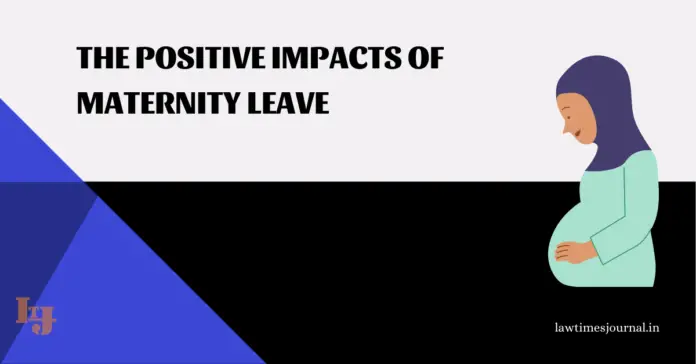
The erstwhile President of India and Bharat Ratna Dr. APJ Abdul Kalam once said that “My mother was a woman of love, kindness and, above all, a divine nature. I firmly believe that the respect that its women enjoy tells us how developed a country is.” Long back, Charles Fourier had affirmed that the extension of women‘s rights is the basic principle of all social progress, Henrik Ibsen accentuated the individualism of woman and John Milton treated her to be the best of all God‘s work.
As we delve into this new decade, every individual must now be ascertained an equality of opportunity with the other individuals to live his or her own life without being perturbed by the prejudicial encumbrances based on certain prohibited grounds of discrimination, including that of gender or sex.
Regardless of all the legislative revamping, discrimination against women pertaining to the maternity is inescapably, a ubiquitous problem throughout the world. A prodigious majority of women workers in the world – around 830 million – do not receive the apposite maternity protections, to which they’re entitled. Almost 80 per cent of these workers belong to Africa and Asia.[1]
When the mothers are made to reluctantly reapportion their time and efforts from the care of their now born child to their employment work, it could be seriously pernicious for the health and well-being of the child as well as her mother.[2]
Safe maternity and health care for mother and infant survival is therefore the quintessence of life itself. It is also paramount for promulgating decent working conditions and gender equality at the workplaces while proselytizing the efficiency and productivity of the women employees. Maternity protection is consequently an inherent and fundamental labour entitlement manifested in key universal human rights treaties in order to support gender equality and facilitate a more equal labour market participation of men and women.[3]
The foremost motivation for pioneering and expediting maternity leaves is to provide a suitable period of time for the mother to fully recuperate from giving birth and to bond with her newborn child while having an opportunity to return to the pre-birth employer effectuating career continuity after the birth event.[4] The provision of maternity leave would thus ameliorate the retention of women during the period of child-rearing[5], perpetuating their work experience and job tenure and thereby allowing them to maintain good job matches and higher wages.[6]
Maternity leave policies may have long-term effects on mother’s health by obviating or alleviating the stress and anxiety around childbirth as new mothers are often exposed to the risk of acquiring a range of psychiatric disorders including depression, posttraumatic stress disorder, anxiety and postpartum psychosis. Almost 10% to 15% of mothers undergo depression in the postpartum period, which may engender vulnerability to ensuing occurrences of major depression and other psychiatric disorders in the older age.[7] A positive relationship between longer maternity leave periods and the mental health of mothers after birth was established in four out of six studies.[8] Well-crafted maternity leave facilities have also been constantlyrelated with the reduced infant and child mortality rates.[9]
Other additional longer term benefits attributed to maternity leave include longer periods of breastfeeding and lower accident rates in the child’s first year and better postpartum physical and mental health for the mothers.
While there remainsa linear and positive relationship between the maternity benefit provisions and infant/child health, how substantially a mother gets benefitted from the same is more often determined by her education levels and economic status.
Having mentioned so, it is quite pertinent that the veneration and protection of woman and of maternity must be augmented to the status of an inalienable social duty and should become one of the fundamentals of human morality to ensure that the women are dispensed with what is due to them.
The reverence of life is insegragably associated with the dignity of a human being who is basically divine, not servile. A human personality is endowed with potential infinity and it blossoms when dignity is sustained. The sustenance of such dignity has to be the superlative concern of every sensitive soul. The essence of dignity can never be treated as a momentary spark of light or, for that matter, ‘a brief candle’, or ‘a hollow bubble’. The spark of life gets more resplendent when man is treated with dignity sans humiliation, for every man is expected to lead an honourable life which is a splendid gift of “creative intelligence”.
– Albert Schweitzer
“The views of the authors are personal“
Reference-
1.“Maternity and paternity at work- Law and practice across the world”, International Labour Organisation https://www.ilo.org/wcmsp5/groups/public/—dgreports/—dcomm/documents/publication/wcms_242617.pdf
2. Pinka Chatterji, Sara Markowitz, and Jeanne Brooks-Gunn, Effects of early maternal employment on maternal health and well-being, https://www.ncbi.nlm.nih.gov/pmc/articles/PMC3640562/
3. Hanna Röth, André Bongestabs and Zina Nimeh Impacts of maternity policies; Impact of Maternity policies, The socio-economic impact of social security, International Social Security Association, Geneva, 2016
4.Baker, M. and K. Milligan (2008a): “How Does Job-Protected Maternity Leave Affect Mothers’ Employment?” Journal of Labor Economics, February 2008
5.Waldfogel, J. 1998. “Understanding the ‘family gap’ in pay for women with children”, in The Journal of Economic Perspectives, Vol. 12, No. 1.
6.Hamish Low & Virginia Sanchez-Marcos, “Female labour market outcomes and the impact of maternity leave policies”, IZA Journal of Labor Economics, https://izajole.springeropen.com/articles/10.1186/s40172-015-0029-1
7.Avendano, M., L. F. Berkman, A. Brugiavini, and G. Pasini (2015): “The Long-run Effect of Maternity Leave Benefits on Mental Health: Evidence from European Countries,” https://www.ncbi.nlm.nih.gov/pmc/articles/PMC4400242/#R7
8.Staehelin, K.; Bertea, P. C.; Stutz, E. Z. 2007, “Length of maternity leave and health of mother and child–a review”, in International Journal of Public Health, Vol. 52, No. 4.
9. Ruhm, C. J. 2000. “Parental leave and child health”, Journal of Health Economics, Vol. 19, No. 6.





